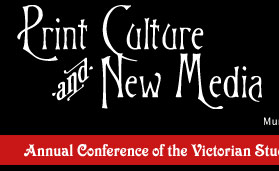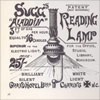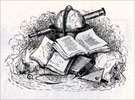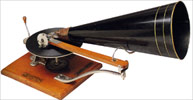








Plenary Papers
Rob Breton (English Department,
University of British Columbia)
" Sensation Writing and the Development of a Chartist Aesthetic"
I argue that Chartist intellectuals turned to and borrowed from "sensational" working-class styles in order to differentiate themselves from the dominant middle-class rhetoric of the day and to confirm a distinctive working-class genre. I suggest that the addition of melodramatic devices to an essentially intellectual form was a symbolic gesture made by Chartist intellectuals - many of whom were outsiders to the class they sought to empower - to the traditions of working-class writing. To do so I look at Chartist periodical writing, mostly the Northern Star, and the fusion of dramatizing and intellectualizing discourses within it.
Pamela Dalziel (Associate Professor, English Department, University of
British Columbia)
“
Images, Icons, and Celebrities: Hardy’s New Men and (Not-So-)New
Women from Print to Film”
Focusing on the representation and production of gender in relation
to different media, my paper will analyze image-text relations from
serial to film in three Hardy novels. Herkomer’s celebrated opening
illustration to Tess was extensively reproduced, imitated, and parodied,
and has
determined how Tess—and “Hardy”—has been defined
by academics, film-makers, and the general public. My analysis of film
directors’ attribution
of “authority” to the serial illustrations to Tess, The
Well-Beloved,
and Jude will demonstrate how Victorian visual media have contributed
to our society’s definitions of visuality, specifically the cult
of celebrity and representation of “new” masculinity
and femininity.
Cecily Devereux (Associate Professor, English Department, University of
Alberta)
“ The Graphics of Empire: Occidentalizing Book Art in Late 19th
and Early 20th Centuries”
Stephen Donovan (Postdoctoral Research
Fellow, Blekinge Institute of Technology, Karlskrona, Sweden)
“Alfred Harmsworth and The Story of Today: Fiction and
Newspapers in Britain, 1880-1920”
This paper offers an examination
of the career of Alfred Harmsworth in relation to newspaper and magazine
fiction during the late-nineteenth-century
boom in periodical publishing in Britain. It argues that fiction,
as a category of printable material and an array of narrative structures,
held
a special appeal for Harmsworth. More than just sources of revenue,
short stories and serial novels represented for him a unique avenue
for interpellating
the new readership of his publications, which he exploited in a number
of different ways. The first half of the paper accordingly examines
the political and cultural stakes of the intersection of fiction
and news-reporting in two case studies: Harmsworth’s attempt to influence the parliamentary
election in Portsmouth in 1895 through the serialization of Beckles Willson’s The Siege of Portsmouth in the Southern Daily Mail; and the Daily
Mail’s invented account of the massacre of the European diplomatic
missions to Peking in 1900. The second half of the paper focuses on the
representation
of Harmsworth in a dozen contemporary novels and numerous magazine
articles, including Marie Connor Leighton’s A Napoleon of the Press (1900),
Joseph Conrad and Ford Madox Ford’s The Inheritors (1900),
Keble Howard ’s Lord
London (1913), and W. L. George’s Caliban (1920).
Nadja Durbach (Associate Professor, Department of History, University
of Utah)
“ The Missing Link and the Hairy Belle: Print Culture and the
Victorian Freakshow”
In 1883 "Krao, the Missing Link" was on exhibit in London. The
texts that accompanied Krao's exhibition illustrate the ways in which
this hirsute child served as a focal point for debates over Darwin's
theory. The visual representations of Krao that circulated in popular culture
in
the 1880s, however, tell a different story. Between 1883 and 1886,
Krao's portrayal was in the process of shifting from a playful monkey-child
to
a highly sexualized young woman. The tensions between Krao's visual
and textual representation thus reveal the multiple ways in which
the body
of the freak was marketed to, and read by, a curious public.
Carmen Ellison (Doctoral Candidate, English Department, University of
Alberta)
“‘Written on a Fly Leaf’: Queen Victoria’s First Poet
Laureate & the Politics of Poetic Privacy”
Monica Flegel (Doctoral Candidate,
English Department, University of Alberta)
“
Fact and their Meaning”: the NSPCC and the Emergence of Casework
in Late Nineteenth-Century England
In this paper, I will examine the role that casework – and its products,
the casepaper and the case study – played in delimiting and defining the
emergent concept of child abuse in nineteenth-century England. Looking at examples
of casework from the National Society for the Prevention to Cruelty to Children
(NSPCC), I will argue that while the rigid format of casework restricted what
could be said about cruelty to children, the casepapers themselves provided the
Society with ample material for its own propaganda, material which was made to
mean in a complex variety of ways. However, though the Society’s casework
allowed it to both control the kinds of questions that were asked about child
abuse and to employ the answers to those questions to meet its own needs, it
also, I will argue, revealed the faultlines within the NSPCC’s own
rationality.
Stefania Forlini (Doctoral Candidate. English Department, Simon Fraser
University)
“
Arthur Machen’s Books and Other Objects: Exploring Decadent Gothic
Artifice”
As both a self-consciously stylized narrative and a stylized object
(first published as part of John Lane’s Keynote series) Arthur Machen’s
decadent Gothic novel, The Three Imposters (1895), raises a number
of questions about the relations between decadent Gothic and the
book as object and
the significance of the decadent “cult of artifice” to late
Victorian notions of the human. With its foregrounding of objects as the
driving force of its plot and its apparent awareness of itself as stylized
object, this text examines a “cyborgian” world in which humans
become secondary to the circulation of objects and the “mechanism” of
the city comes alive.
Grace Kehler (English Department, McMaster University)
“The Victorian Garden Book: re-Presenting Nature-Culture
Relations”
Chris Kent (History Department, University of Saskatchewan)
“Addressing the Victorian gentleman: Body Politics in The
Tailor and Cutter”
The Victorian gentleman and his tailor coexisted in a fraught symbiosis.
The tailor’s livelihood depended on his client. The gentleman’s
outward identity depended on his tailor. The balance of power in
this relationship was delicate, particularly for the tailor who occupied
a liminal social
position. The Tailor and Cutter, the leading journal of the high-class
tailoring trade, instructed its readers on how to address, as well
as dress, the gentlemany body.
Charles Pierre La Porte (Assistant
Professor, Vanderbilt University, Nashville, Tennessee)
“Victorian Poets and the Reproduction of the Bible”
This paper shows how the controversies and conflicts surrounding
the New Revised Version (NRV) of the Bible mirror controversies among contemporary
poets. Conservative readers disparaged the NRV because they desired a lucid
and necessarily single text of the Bible (the NRV included marginalia
and glosses that encourage multiple interpretations). This conflict
is interestingly
paralleled in secular poetry. Whereas William Morris’ Kelmscott productions
efface thorny historical editorial problems in order to appeal to an “ideal
book,” Tennyson’s Idylls openly celebrates the textual fragmentation
of the national Arthurian legends.
Kirsten MacLeod (Postdoctoral Fellow, English Department, University
of Alberta)
“Between the Triple-Decker and the Modernist Novel: Decadence
and the Transformation of the British Novel in the Age of Mass Print”
This paper examines the transition between the Victorian triple-decker
novel and the modernist novel as exemplified in the largely forgotten
decadent novels of the 1880s and 1890s, novels that were hybrid mixes
of the traditional
Victorian and the emerging modern. It examines the obstacles faced
by the proto-modernist decadents in modernizing the novel in the
face of an increasingly
commercialized literary field and explores to what extent the hybrid
form of these novels was determined by the conditions of cultural
production in the fin-de-si ècle literary field.
Juliet McMaster (Professor, English Department, University of Alberta)
“Sambourne, Punch, and the Royal Academy”
This paper concentrates on Edward Linley Sambourne’s portrayals
of the art world, with slides and commentary on some of his major
graphic works. It
will examine his work in relation to Punch’s influence on public
perception
of the Royal Academy, as well as the artists themselves. Sambourne’s caricatures
familiarised and humanised these celebrated figures; the reviews parodying the
highly academic historical paintings has much to do with the move in subject
matter toward contemporary subjects and local landscapes. Through it s considerable
circulation Punch helped to make the Academy and its members famous; but
at the same time by its satire and deflationary tactics it also succeeded, at
least intermittently, in toppling the prestigious institution from its high horse.
Suzanne Nunn (Art and Media Faculty, Cornwall College, Falmouth)
“ Picturing the Sewers: London Main Drainage and the Illustrated
London News”
This paper will examine visual representations of the building of
London’s sewers in the Illustrated London News special supplement ‘London
Main Drainage’ (31 November 1861). I demonstrate through close visual
analysis, that these illustrations are not transparent, but subtly
communicate ideas about society, and the metropolitan environment
through a visual
language that was unique to illustrated journalism. Exploring the
use of the picturesque and the industrial sublime as visual strategies
for structuring
the world, I argue that these images embodied specific ways of seeing
and actively participated in the construction of Victorian identities.
Ellen L. O’Brien (School of Liberal Studies, Roosevelt University,
Chicago)
“Broadside Ballads and the Poetics of Everyday Life”
In the broadside ballad trade, anonymous ballad writers and their
publishers generated a massive body of literature, complete with
genre codes, stylistic consistencies, and thematic conventions. Viewed
collectively,
these texts also engage history—viewed variously by critics as micro-history,
counter-history, or simply scraps of history. Because of their literary
and historical meanings, broadsides provide useful resources for studying
how working-class life was articulated in nineteenth-century Britain. This
talk scrutinizes broadside ballads’ representations of everyday,
working-class life and, in doing so, addresses two central issues:
the signifying practices of this everyday form of print culture and the explicit
narrativization and thematization of everyday life in specific ballads
and ballad subgenres.
Clarrisa Suranyi (English Department, University of Western Ontario)
“Detecting the Typewriter: Tools of Crime and Double Agents in
the Fiction of Doyle, Allen, and Gallon”
The Sherlock Holmes stories resist the distancing function of technology,
reassuring the reader that the personal and the individual is still present,
even in the machine age. Holmes has mastered modern technology, including
the typewriter, and is able to recognize the marks of the machine on
the body. The women typists in the Holmes stories are either figuratively
or
literally blind, becoming tools used by the criminals, and to some extent,
by Holmes himself. In contrast, the female protagonists of Grant Allen’s
Miss Cayley’s Adventures and Tom Gallon’s The Girl Behind
the Keys, are both detectives and sharp-eyed typists who are given remarkable
power and intelligence. In both Allen’s and Gallon’s novels,
however, conventionality is reinscribed as the protagonists’ careers
end with their marriages.
Lisa Surridge (Associate Professor,
English Department, University of Victoria)
“Strange Revelations: The Divorce Court,
The Newspaper, and The Woman in White”
Just as the 1828 Offenses Against the Person Act brought working-class
violence into the public eye, the 1857 Divorce Act brought middle-class
domestic conduct under unprecedented scrutiny. I will argue that
Wilkie Collins’ The Woman in White (1859-60) is structured
like a marital cruelty trial, with its serial format, multiple witness
statements, use
of servants as narrators, and probing of Sir Percival’s domestic
conduct. Marlene Tromp argues that sensation fiction played a key
role in exposing marital violence to the Victorian public. In my
view, however,
no incident of wife abuse in The Woman in White exceeds the revelations
of marital cruelty in Divorce Court journalism. Instead, I contend that
the sensation novel and the newspaper together participated in the exposure
of marital cruelty which Tromp attributes to sensation fiction alone.
Vanessa Warne (Assistant Professor, English Department, University
of Manitoba)
“Embossed Scripts: Bookmaking and Blind Readers in Victorian
Britain”




